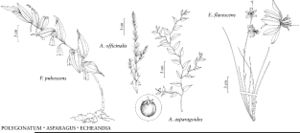Echeandia
Nov. Pl. Descr. Dec., 135, plate 18. 1800.
| Taxon | Illustrator ⠉ | |
|---|---|---|
 | Polygonatum pubescens Asparagus officinalis Asparagus asparagoides Echeandia flavescens | Yevonn Wilson-Ramsey Yevonn Wilson-Ramsey Yevonn Wilson-Ramsey Yevonn Wilson-Ramsey |
Herbs, perennial, scapose, from corms with enlarged storage roots. Leaves basal and cauline; blade 2-faced, very narrowly linear to narrowly oblong or elliptic, base surrounded by fibrous leaf-bases from previous year. Inflorescences racemose or paniculate, (1–) 2–4 flowers per node. Flowers bisexual or pseudohermaphroditic-staminate, ± erect to pendulous; tepals strongly reflexed to spreading, distinct, yellow [orange, white, or cream], 3-veined, ± elliptic, equal; stamens 6; filaments linear to clavate, bearing scales at right angles to axis of filament [scaleless]; anthers connate into cone or distinct, dorsifixed near base, yellow; ovary superior, ellipsoid, ovules 8+ per locule; style 1. Fruits capsular, broadly to narrowly oblong, dehiscence loculicidal. Seeds black, irregularly compressed and folded, colliculose. x = 8.
Distribution
sw United States to nw Argentina, s Bolivia, and s Peru
Discussion
Species ca. 80 (3 in the flora).
More than 60 species of Echeandia occur in North America south of the United States. Two of those reach their northern distributional limits in the southwestern United States. The third species included here is known only from the southern tip of Texas.
Selected References
None.
Lower Taxa
Key
| 1 | Anthers connate, 4 mm or longer. | Echeandia texensis |
| 1 | Anthers distinct, shorter than 4 mm. | > 2 |
| 2 | Filaments inserted in open pits; anthers versatile; most storage roots 1–2(–4) cm from corms. | Echeandia flavescens |
| 2 | Filaments inserted in covered pits; anthers not versatile, usually twisted and/or reflexed, thus appearing versatile; most storage roots 2–8 cm from corms or thickened through out. | Echeandia chandleri |
"broad" is not a number."thicker" is not a number.